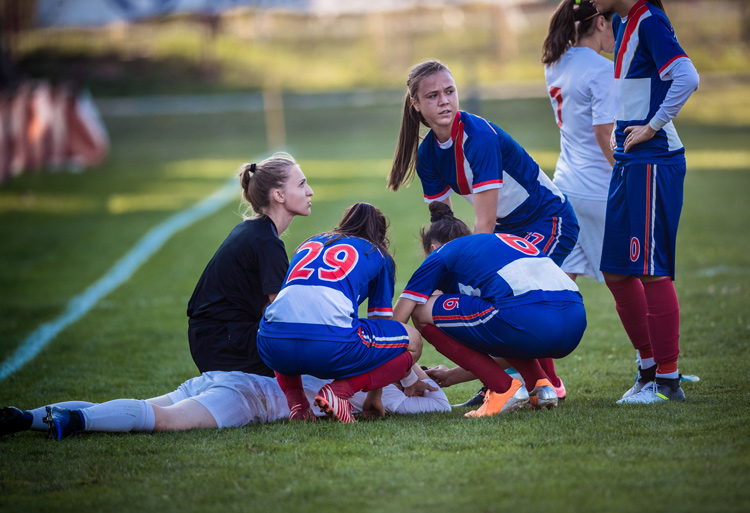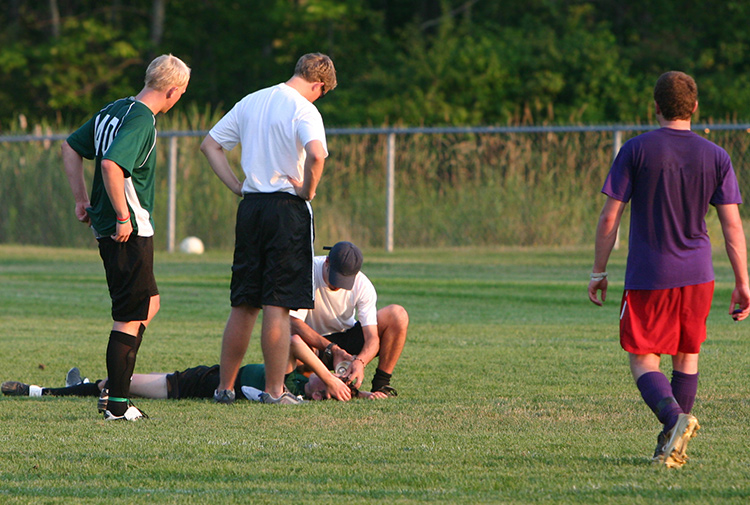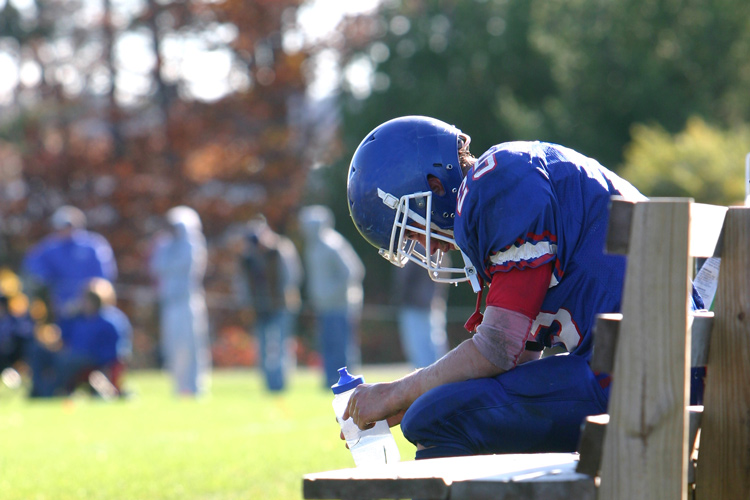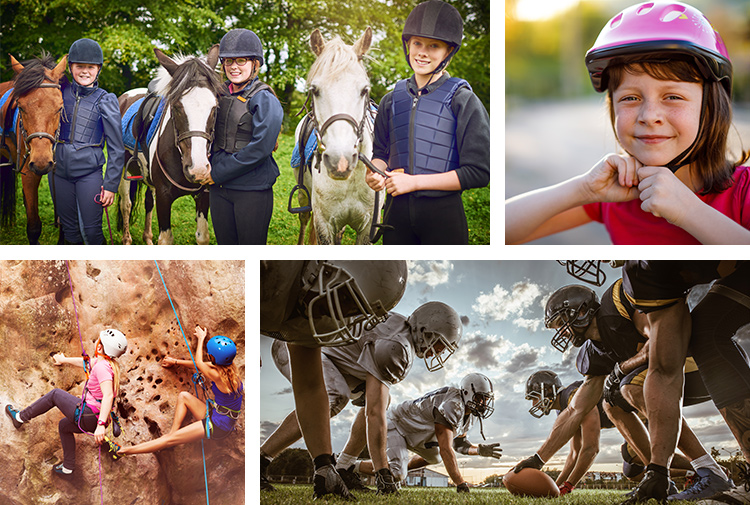Concussion in Australian Sport
Concussion affects athletes at all levels of sport from the part-time recreational athlete through to the full-time professional
Information for Athletes
The AIS believes it is important that athletes are equipped with the knowledge and tools to help them have a long and healthy sporting career.
This is why the AIS Concussion and Brain Health Position Statement 2024 has been expanded to provide information and resources for female athletes and para-athletes and athletes with disabilities.
The following resources have been designed to provide an athlete’s voice on concussion in sport.
The athletes below have shared their real-life experiences to share what it is like to go through the diagnosis and treatment of concussion.
It is important to remember every concussion is different and if in doubt, sit them out.
Stories
Anabelle Smith and the importance of performance support services
While three-time Olympic Diver Anabelle Smith is fortunate enough to have never experienced a concussion herself, the 30-year-old has a trusted performance support system around her if the worst were to happen.
In her 15-years as a Victorian Institute of Sport (VIS) athlete, the Commonwealth Games gold medallist has been surrounded by a team of physiotherapists, sport doctors, psychologists and others who she said have always had her best interests at heart.
"I think every athlete understands that we don't get to be the best in the world if we don't have that huge support network around us," Smith said.
"I have full trust the VIS team are looking after me physically, mentally and emotionally, which allows me to go to competitions and perform at my best knowing I have a team behind me supporting me every step of the way."
Despite not having experienced a concussion, the Victorian has completed her fair share of concussion tests and said having trust in her performance services team is critical throughout the process.
"When it comes to something as serious as concussion, I think it's important athletes understand the process and the" purpose behind concussion testing too.
"For me trusting my team know what they’re doing and are putting me in the best position to get back into the diving pool is super important."
The World Champion diver encouraged athletes to prioritise building strong relationships with their performance support team in case the worst-case scenario happens.
"To have a really safe and comfortable relationship with your performance support team is integral in any recovery process, whether that is a ruptured achilles or a concussion."
Emily Hamilton-Smith's experience with delayed concussion symptoms
Emily Hamilton-Smith copped a rogue ball to the head during the 2022 Hockey One semi-final, but it wasn’t until a few days later she felt the impact of the injury.
The Hockey Club Melbourne defender said she felt nothing more than a lump on her head immediately after the incident but completed a range of concussion tests with the team physio out of precaution.
The twenty-one-year-old passed the concussion tests and went on to play in the bronze medal match, before returning to work and life as normal after the Hockey One season.
"It wasn't until a few days after the match that I began getting headaches, feeling nauseous and was unable to concentrate for short periods of time," Hamilton-Smith said.
"I also realised I couldn't remember anything from the game, so I decided to reach out to my doctor."
Hamilton-Smith's doctor diagnosed her with concussion and advised her to stay off her phone and avoid doing activities that required large amounts of concentration and physical activity until she could pass the necessary recovery milestones.
"I had never had a concussion before, but I knew I had to take it really seriously because obviously it’s your brain," Hamilton-Smith said.
"I had a camp coming up so I knew if I did everything right at the time, I’d be in the best possible position I could be for the camp."
While she went on to make a full recovery, Hamilton-Smith acknowledged that it wasn’t until she experienced a concussion herself that she understood the impact it can have on someone.
"It's super important that people who haven't had a concussion know what it's like so they can understand the physical and mental challenges that people with concussion are going through."
Maddy Proud navigates concussion in professional netball
New South Wales Swifts co-captain Maddy Proud knows only too well how important it is for athletes to correctly manage concussion after coming under friendly fire during a Diamonds test against England in 2022.
"I got an elbow to the face and hit the ground straight away. I instantly knew something wasn’t right," Proud said.
"I was a bit out of it for a few minutes, so I went off and into the changerooms to do a concussion test."
Proud said her symptoms became intense during testing, saying she felt like she was going to throw up when asked to follow a doctor’s finger movement with her eyes.
Following her concussion diagnosis, Proud also experienced persistent headaches, brain fog, and fatigue, and said her Diamonds coach Stacey Marinkovich, played a big role in her recovery.
“My coach was one of my biggest advocates for making sure I took enough time to recover because she knew what I was like when I was at 100 per cent, and she knew I wasn’t there yet.
"It's funny how your coaches end up being more in tune with yourself than you are."
Marianna Tolo’s experience watching teammates suffer concussions
While she has never personally experienced a concussion, Australian Opals star Marianna Tolo has witnessed many head knocks during her illustrious career that has included three Olympic Games and four WNBL titles.
One occasion during her time playing overseas highlighted the importance Australian sport places on proper diagnosis and treatment of concussion.
"My teammate got an elbow to the head and straight away felt dizzy and couldn’t concentrate. She spoke to the medical staff, and they just said to take it easy – we didn’t have a concussion protocol in place.
"Seeing the difference in medical care overseas made me feel really grateful to be Australian because our medical staff have the knowledge and resources to help you through concussion diagnosis and recovery."
The 2024 AIS Concussion and Brain Health Position Statement provides clear return to sport protocols after concussion.
To align with both the UK and New Zealand, the AIS advises a minimum standdown period of 14 days symptom free (at rest) before returning to contact sport training and a minimum of 21 days before returning to competitive contact for all youth (under-19s) and community sport.
For high performance and professional athletes over the age of 19 with daily access to heath care professionals, the advice is at least ten days symptom-free before returning to contact activities.
Tolo said important athletes are aware of the guidelines and don’t try and hide head knocks and symptoms to keep playing.
"One of my teammates got a knock to the head and wasn’t feeling 100 per cent but didn’t want to talk to the doctor because she didn’t want to miss the World Cup at home.” Tolo said.
"A couple of us convinced her to see the doctor and she ended up being able to continue to play.
"This shows that getting tested doesn’t always mean you will have to sit out, but if you do go onto play and you weren’t supposed to the consequences could be quite high."
Tolo encouraged all anyone experiencing any concussion symptom to seek help from trusted medical professionals.
"I really encourage all people to seek help and advice from professionals no matter the severity, because you never know what might happen. You might seem fine now but down the track you never know."
Rachael Lynch proves experience is no defense against concussion
As a dual Olympian, Commonwealth Games gold medallist and the most capped Hockeyroo goalkeeper in history, Rachael Lynch knows it’s not always easy to put your health before sport when dealing with a concussion.
But the Melbourne-born star, who played more than 230 games for Australia, says a scary incident from the 2014 Women’s Hockey World Cup in The Hauge always reminds her that when it comes to concussion, it’s always safest to follow the advice of the AIS Concussion and Brain Health Position statement: “if in doubt, sit them out”.
She recalled: "I came out and did a slide tackle with a player. I got the ball, but the player kept going and kneed me in the head, making my helmet come off.”
Lynch said she continued to play the remainder of the game despite feeling the early signs of concussion.
"My role as a goalkeeper is to call out penalty corners - we have four words that we use to call the different variations."
"At halftime I remember coming off and having to ask the other goalkeeper what they were because I had completely forgotten."
In hindsight, Lynch, who is a Registered Nurse, admitted she should have known better and warned others about the dangers of not speaking up when experiencing any concussion symptoms.
"I know I should have flagged it with our physio and doctor, but I was caught up in the moment of the game and didn’t say anything."
"With any sport, people are so competitive, and I think the adrenalin of the moment can sometimes impair your willingness to raise issues."
"I think as an athlete, understanding the long-term effects that can come from what you might feel is an innocuous incident and reporting it to a professional is really important."
Two-time Paralympian Sam Carter’s frightening mid-race concussion
Paralympic sprinter Sam Carter, 32, was flying down the back straight of the Blacktown Athletics Track competing in the 2016 Australian Championships T54 relay - the next thing he remembers was being picked up off the track.
"There was an athlete in my lane I wasn’t anticipating, and I didn’t have my head up, as I tend not to do when I’m racing,” Carter said."
"I was going about 35 kilometres an hour when I ran straight into the back of them."
"I came out of my chair and was thrown through the air a couple of metres before hitting the track pretty hard."
The Queenslander was helped off the track and taken to hospital in an ambulance, where he was diagnosed with a concussion.
Being his first and only concussion, Carter said he was surprised by some of the symptoms he endured following the accident.
"Initially, I recall being disorientated and my recollection of the event was pretty fuzzy."
"Soon after, I developed nausea and vomiting and was definitely more emotional and just out of soughts for the first couple of days after the incident."
Carter said he worked with his doctor and physiotherapist during his recovery – a process that took longer than he expected.
"I did a range of cognitive tests to track my recovery and see when I could return to training."
"It took about two weeks for me to start light training and then another ten days until I felt like I was back at normal."
"It took longer than I expected, but I was glad my GP and Physio were being thorough."
The Paralympian encouraged other athletes to share their concussion stories, so others don’t feel alone if they are unfortunate enough to suffer a concussion.
"I hadn't really had any conversations with anyone before the incident about what having a concussion or recovering from a concussion would entail, so, it was a bit scary."
"It's one thing to hear information from medical personnel, but another to get that firsthand experience from other athletes."
"To have had an athlete to speak to or to say this is what I felt, would have been really helpful."
"There is no such thing as a good concussion, and we need to be concerned about each concussion and manage each concussion seriously."
Dr David Hughes, AIS Chief Medical Officer
What is concussion?
Concussion is a brain injury caused by a knock to the head or anywhere on the body, where the force is transmitted to the head. It can also be caused by a fall. Concussion involves temporary; neurological impairment. The symptoms may evolve over the hours or days following the injury.
While all concussions should be assessed by a doctor, most will resolve without the need for specific treatment. A short period (24-48 hours) of relative rest, followed by gradual return to activity is the main treatment.
All concussion is serious.

How to recognise concussion
Recognising concussion can be difficult. It is important to know when to suspect concussion, because appropriate response and management can help prevent further injury or even death. There are several possible symptoms and signs, but they can be subtle and they are not specific only to concussion.
Onlookers should suspect concussion when an injury results in a knock to the head or body that transmits a force to the head. A hard knock is not required—concussion can occur from relatively minor knocks.
Use the Concussion Recognition Tool 6 to help you recognise concussion.
What are the signs and symptoms of concussion?
The signs of concussion vary and may be difficult to detect. For example athletes may:
- appear normal apart from appearing vacant, dazed or stunned
- be disoriented and unable to recall team plays, scores, who the opponent is or be disoriented in terms of place and time
- ask repeatedly about what happened or what the score is; amnesia is common
- have difficulty concentrating and answering specific questions.
Loss of consciousness, seizure or balance difficulties are clear signs that an athlete has sustained a significant injury. Urgent medical support is critical in these circumstances.
Symptoms of concussion can be very subtle and may present as nothing more than the athlete reporting that they do not ‘feel right’. Concussed athletes often report these symptoms:
- visual disturbance
- feeling ‘foggy’, lethargic or slow
- having sensitivity to light or noise
- feeling dizzy or nauseous
- headache.
Athletes need to be alert for evidence that a teammate or competitor is behaving unusually or out of character, exhibits signs of disorientation, clumsiness or loss of balance.
Critical symptoms/signs | Obvious symptoms/signs | Subtle symptoms/signs |
|---|---|---|
|
|
|
If an athlete displays these symptoms/signs they may have a more serious injury. They should be immediately taken to the nearest emergency department. | ||
What to do for suspected concussion
First-aid principles apply. Neck injuries should be suspected if there is any loss of consciousness, neck pain or a mechanism that could lead to spinal injury. Athletes in this type of situation shouldn’t be moved without guidance from appropriately trained individuals.
To assist the treating health practitioner, it is helpful to note the following details at the time of the injury:
When: what time did the injury take place?
How: how did the injury occur? For example, is the injury from a knock to the head by a cricket bat or by an opponent’s shoulder?
Where: where on the body was hit? For example, the temple, shoulder or back of head.
What: what occurred next? Including symptoms such as loss of consciousness, convulsions, amnesia, vomiting or confusion.
Additional useful information: any further symptoms such as behavioural changes or loss of memory.
If in doubt, sit them out!
If there is any doubt about whether an athlete is concussed, that athlete should not be allowed to return to sport until cleared by a medical practitioner.
Diagnosis of concussion
The diagnosis of concussion should be made by a medical practitioner. They will take a clinical history and conduct an examination taking into account how the athlete was injured, symptoms and signs, cognitive functioning and neurological assessment including balance testing.

How to manage concussion
Any athlete with suspected or confirmed concussion should:
- remain in the company of a responsible adult
- not be allowed to drive
- be advised to avoid alcohol
- check their medications with their doctor.
Specifically, concussed athletes should avoid:
- aspirin
- anti-inflammatories (such as ibuprofen, diclofenac or naproxen),
- sleeping tablets
- sedating pain medications.
If diagnosed with concussion, athletes should have immediate physical and mental rest; this allows the brain to ‘rest’ and helps recovery.
To properly rest, time off school or work may be needed. Mental rest may include refraining from playing computer games, reading and watching television.
Children and adolescents
Children and adolescents aged 18 years or younger take longer to recover so a more conservative approach to concussion management should be taken. Concussive symptoms usually resolve in less than four weeks.
The child should be completely free of symptoms for at least 14-days before returning to contact or collision activities.
Return to learn
‘Return to learn’ is about the athlete’s gradual return to their usual program at school or work.
Having rested for 24 - 48 hours after sustaining a concussion, school-age athletes can return to school or study - as long as these activities don’t worsen symptoms. Thinking or concentrating for long periods can bring on or worsen symptoms of concussion. Gradually increasing the load on the brain without provoking symptoms is recommended. School programs may need to be modified to include more regular breaks, rests and increased time to complete tasks. Exams during that period may need to be postponed.
Return to school and learning should take priority before returning to sport. A concussed child should not return to sport until they have successfully returned to normal school activities.
Return to sport
‘Return to sport’ is about the athlete’s gradual return to full sporting activity.
Having rested for 24 – 48 hours after sustaining a concussion, the athlete can begin light physical activity - as long as the activity doesn’t worsen symptoms. Once symptoms have cleared, the athlete can begin a staged return to sport.
These Graded Return to Sport Frameworks can be used to inform Return to Sport programs.
Mental health and concussion
There is a potential link between mental illness and concussion. Athletes with a history of mental illness should discuss this with a doctor. Where there is a history of mental illness, a more cautious assessment and a more conservative management approach should be taken.
There are a number of organisations with information on mental illness and where to go for help:
- Lifeline provides a 24 hour, 365 days per year crisis support and suicide prevention service. It is free and provides immediate support for those in need.
- Headspace is a national youth mental health support service providing mental health assistance to those aged 12–25.
- Beyond Blue is an organisation aimed at improving community mental health education and awareness through several programs.

Long-term consequences of concussion
There has been recent concern about potential long-term consequences of concussion. Chronic traumatic encephalopathy neuropathological change (CTE-NC) is a type of degenerative neurological disease that is associated with a history of repeated head trauma. There has been a growing number of former athletes diagnosed with CTE-NC post-mortem. There are many unknowns about why some athletes are susceptible.
The best way to safeguard the immediate and long term health of athletes is to:
- Remove athletes suspected of having concussion
- Treat each case of concussion carefully
- Adopt a conservative approach to return to sport.
Protective headgear and concussion
Helmets will not stop concussion from occurring.
Current evidence suggests that helmets, mouth guards or other protective wear offer little if any benefit in the prevention of concussion. Research into protective wear is continuing. Protective wear is important, however, for the prevention of other traumatic head injuries such as lacerations, skull fractures and dental injuries.

Sporting code policies
Sporting organisations need to continually review their policies for best practice concussion diagnosis and management.
High-risk sports, such as professional collision sports, need to ensure that medical personnel are appropriately trained in the detection and management of concussion.
Proposed rule changes require careful consideration of the potential benefits versus possible unintended negative consequences.
Sport organisations in Australia continue to monitor the evolving evidence around repetitive head trauma and concussion. Sport organisations continue to introduce changes to rules and regulations to optimise the detection and management of concussion, aligned with the latest evidence.
The increasing awareness of sport-related concussion and the associated community concern mean many sporting organisations have developed their own guidelines for the management of the condition. These guidelines are constantly evolving through ongoing review. There is a strong alignment across the various sporting codes, supported by the latest scientific evidence on concussion diagnosis and management.
The following sports have concussion policies available on their websites:
Under-reporting of concussion is still a problem
Athletes need to have a good understanding of concussion in order to appreciate the importance of reporting symptoms and complying with rest and return to sport advice. Athletes must be able to recognise the symptoms and signs of concussion in order to detect concussion when no medical supervision is present.
